FIAT BRAVO 2013 2.G Owners Manual
Manufacturer: FIAT, Model Year: 2013, Model line: BRAVO, Model: FIAT BRAVO 2013 2.GPages: 299, PDF Size: 5.86 MB
Page 151 of 299
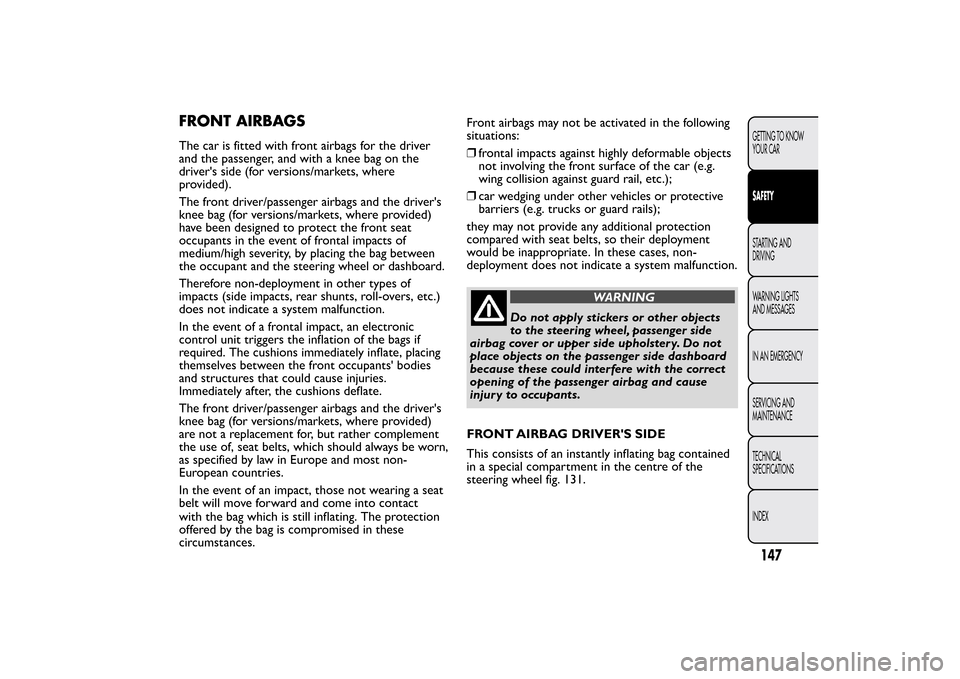
FRONT AIRBAGSThe car is fitted with front airbags for the driver
and the passenger, and with a knee bag on the
driver's side (for versions/markets, where
provided).
The front driver/passenger airbags and the driver's
knee bag (for versions/markets, where provided)
have been designed to protect the front seat
occupants in the event of frontal impacts of
medium/high severity, by placing the bag between
the occupant and the steering wheel or dashboard.
Therefore non-deployment in other types of
impacts (side impacts, rear shunts, roll-overs, etc.)
does not indicate a system malfunction.
In the event of a frontal impact, an electronic
control unit triggers the inflation of the bags if
required. The cushions immediately inflate, placing
themselves between the front occupants' bodies
and structures that could cause injuries.
Immediately after, the cushions deflate.
The front driver/passenger airbags and the driver's
knee bag (for versions/markets, where provided)
are not a replacement for, but rather complement
the use of, seat belts, which should always be worn,
as specified by law in Europe and most non-
European countries.
In the event of an impact, those not wearing a seat
belt will move forward and come into contact
with the bag which is still inflating. The protection
offered by the bag is compromised in these
circumstances.Front airbags may not be activated in the following
situations:
❒frontal impacts against highly deformable objects
not involving the front surface of the car (e.g.
wing collision against guard rail, etc.);
❒car wedging under other vehicles or protective
barriers (e.g. trucks or guard rails);
they may not provide any additional protection
compared with seat belts, so their deployment
would be inappropriate. In these cases, non-
deployment does not indicate a system malfunction.
WARNING
Do not apply stickers or other objects
to the steering wheel, passenger side
airbag cover or upper side upholstery. Do not
place objects on the passenger side dashboard
because these could interfere with the correct
opening of the passenger airbag and cause
injury to occupants.
FRONT AIRBAG DRIVER'S SIDE
This consists of an instantly inflating bag contained
in a special compartment in the centre of the
steering wheel fig. 131.
147GETTING TO KNOW
YOUR CARSAFETYSTARTING AND
DRIVING
WARNING LIGHTS
AND MESSAGES
IN AN EMERGENCY
SERVICING AND
MAINTENANCE
TECHNICAL
SPECIFICATIONS
INDEX
Page 152 of 299
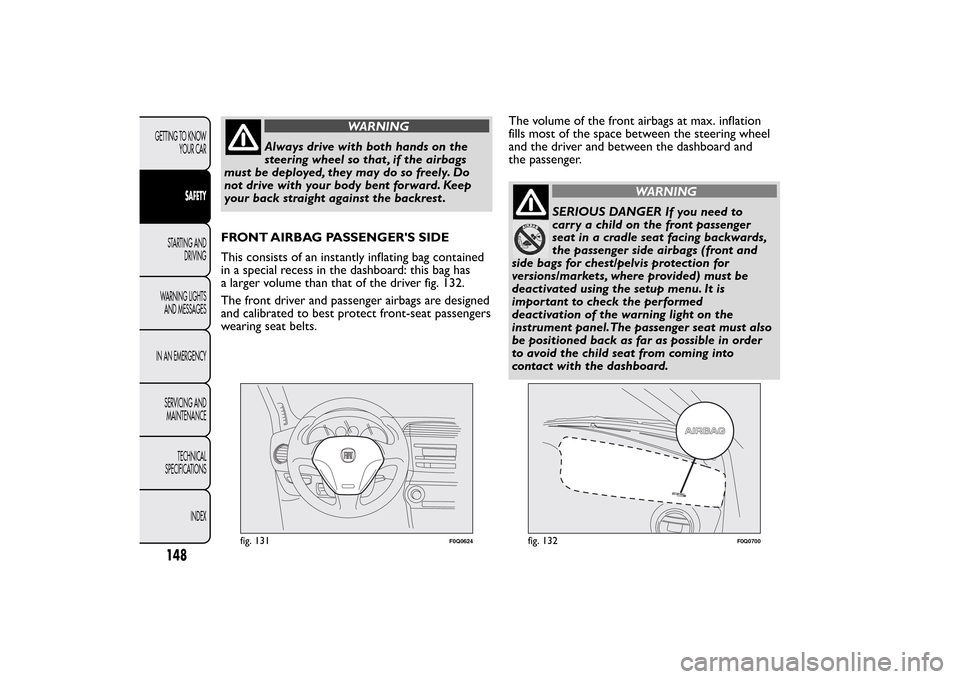
WARNING
Always drive with both hands on the
steering wheel so that , if the airbags
must be deployed, they may do so freely. Do
not drive with your body bent forward. Keep
your back straight against the backrest .
FRONT AIRBAG PASSENGER'S SIDE
This consists of an instantly inflating bag contained
in a special recess in the dashboard: this bag has
a larger volume than that of the driver fig. 132.
The front driver and passenger airbags are designed
and calibrated to best protect front-seat passengers
wearing seat belts.The volume of the front airbags at max. inflation
fills most of the space between the steering wheel
and the driver and between the dashboard and
the passenger.
WARNING
SERIOUS DANGER If you need to
carr y a child on the front passenger
seat in a cradle seat facing backwards,
the passenger side airbags (front and
side bags for chest/pelvis protection for
versions/markets, where provided) must be
deactivated using the setup menu. It is
important to check the performed
deactivation of the warning light on the
instrument panel.The passenger seat must also
be positioned back as far as possible in order
to avoid the child seat from coming into
contact with the dashboard.
fig. 131
F0Q0624
fig. 132
F0Q0700
148GETTING TO KNOW
YOUR CAR
SAFETY
STARTING AND
DRIVING
WARNING LIGHTS
AND MESSAGES
IN AN EMERGENCY
SERVICING AND
MAINTENANCE
TECHNICAL
SPECIFICATIONS
INDEX
Page 153 of 299
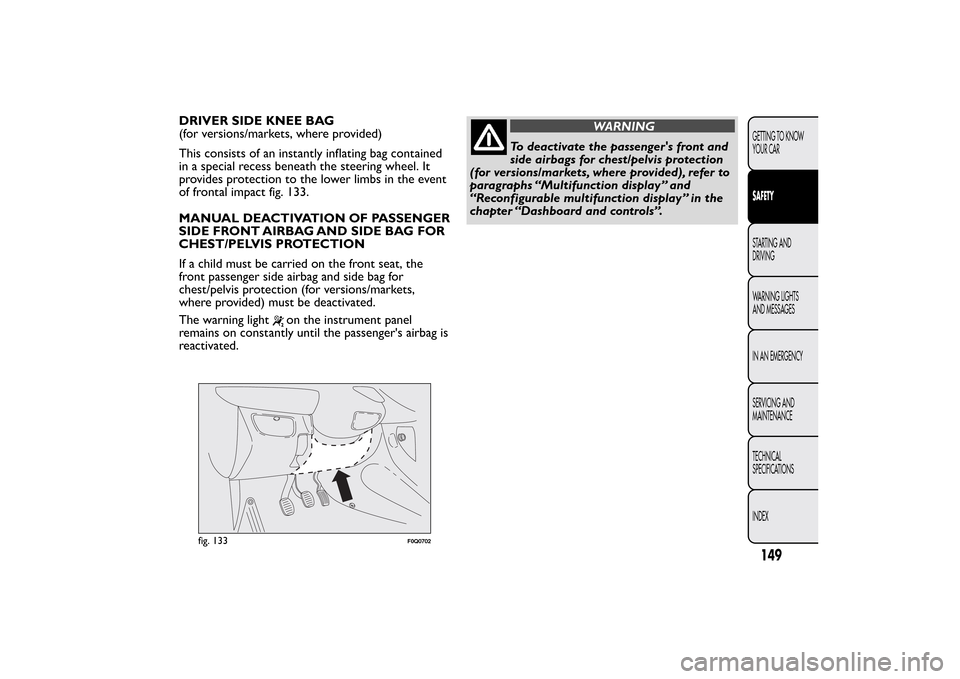
DRIVER SIDE KNEE BAG
(for versions/markets, where provided)
This consists of an instantly inflating bag contained
in a special recess beneath the steering wheel. It
provides protection to the lower limbs in the event
of frontal impact fig. 133.
MANUAL DEACTIVATION OF PASSENGER
SIDE FRONT AIRBAG AND SIDE BAG FOR
CHEST/PELVIS PROTECTION
If a child must be carried on the front seat, the
front passenger side airbag and side bag for
chest/pelvis protection (for versions/markets,
where provided) must be deactivated.
The warning light
on the instrument panel
remains on constantly until the passenger's airbag is
reactivated.
WARNING
To deactivate the passenger's front and
side airbags for chest/pelvis protection
(for versions/markets, where provided), refer to
paragraphs “Multifunction display” and
“Reconfigurable multifunction display” in the
chapter “Dashboard and controls”.
AU
TO
fig. 133
F0Q0702
149GETTING TO KNOW
YOUR CARSAFETYSTARTING AND
DRIVING
WARNING LIGHTS
AND MESSAGES
IN AN EMERGENCY
SERVICING AND
MAINTENANCE
TECHNICAL
SPECIFICATIONS
INDEX
Page 154 of 299
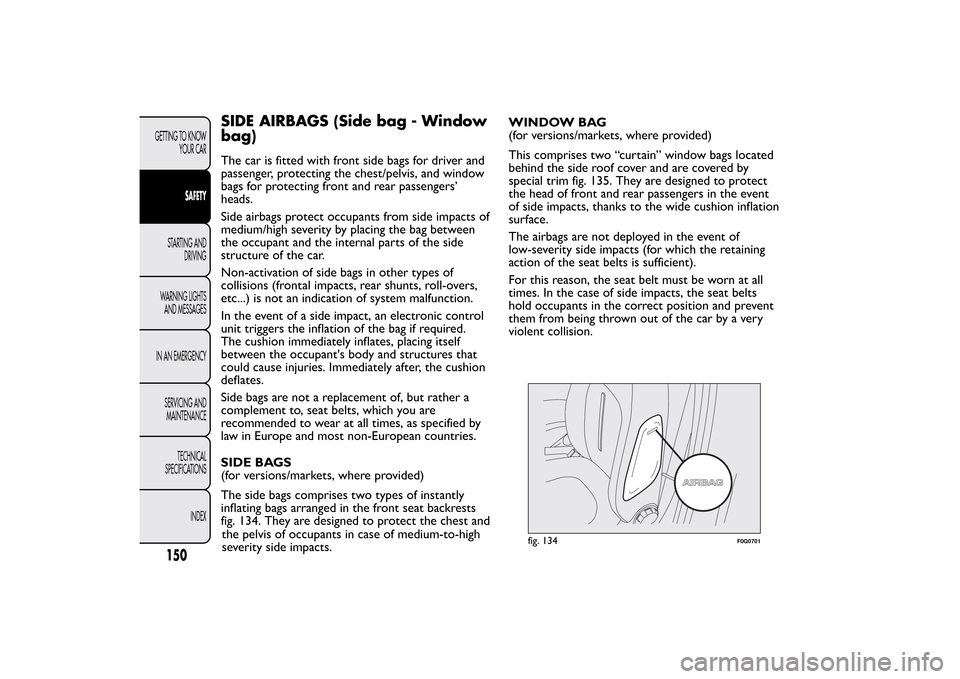
SIDE AIRBAGS (Side bag - Window
bag)The car is fitted with front side bags for driver and
passenger, protecting the chest/pelvis, and window
bags for protecting front and rear passengers’
heads.
Side airbags protect occupants from side impacts of
medium/high severity by placing the bag between
the occupant and the internal parts of the side
structure of the car.
Non-activation of side bags in other types of
collisions (frontal impacts, rear shunts, roll-overs,
etc...) is not an indication of system malfunction.
In the event of a side impact, an electronic control
unit triggers the inflation of the bag if required.
The cushion immediately inflates, placing itself
between the occupant's body and structures that
could cause injuries. Immediately after, the cushion
deflates.
Side bags are not a replacement of, but rather a
complement to, seat belts, which you are
recommended to wear at all times, as specified by
law in Europe and most non-European countries.
SIDE BAGS
(for versions/markets, where provided)
The side bags comprises two types of instantly
inflating bags arranged in the front seat backrests
fig. 134. They are designed to protect the chest and
the pelvis of occupants in case of medium-to-high
severity side impacts.WINDOW BAG
(for versions/markets, where provided)
This comprises two “curtain” window bags located
behind the side roof cover and are covered by
special trim fig. 135. They are designed to protect
the head of front and rear passengers in the event
of side impacts, thanks to the wide cushion inflation
surface.
The airbags are not deployed in the event of
low-severity side impacts (for which the retaining
action of the seat belts is sufficient).
For this reason, the seat belt must be worn at all
times. In the case of side impacts, the seat belts
hold occupants in the correct position and prevent
them from being thrown out of the car by a very
violent collision.
fig. 134
F0Q0701
150GETTING TO KNOW
YOUR CAR
SAFETY
STARTING AND
DRIVING
WARNING LIGHTS
AND MESSAGES
IN AN EMERGENCY
SERVICING AND
MAINTENANCE
TECHNICAL
SPECIFICATIONS
INDEX
Page 155 of 299
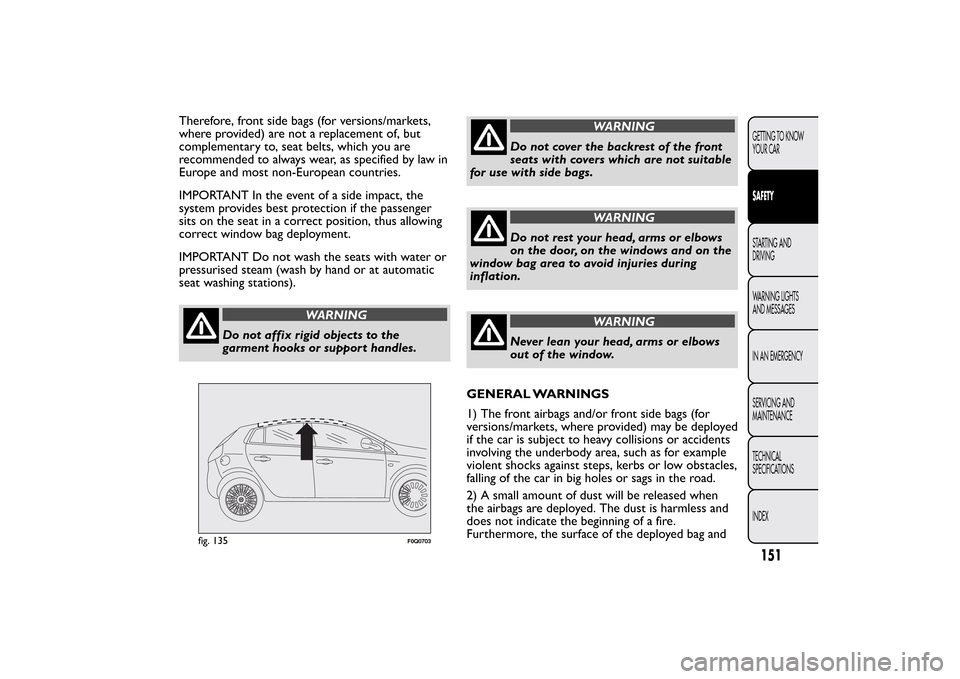
Therefore, front side bags (for versions/markets,
where provided) are not a replacement of, but
complementary to, seat belts, which you are
recommended to always wear, as specified by law in
Europe and most non-European countries.
IMPORTANT In the event of a side impact, the
system provides best protection if the passenger
sits on the seat in a correct position, thus allowing
correct window bag deployment.
IMPORTANT Do not wash the seats with water or
pressurised steam (wash by hand or at automatic
seat washing stations).
WARNING
Do not affix rigid objects to the
garment hooks or support handles.
WARNING
Do not cover the backrest of the front
seats with covers which are not suitable
for use with side bags.
WARNING
Do not rest your head, arms or elbows
on the door, on the windows and on the
window bag area to avoid injuries during
inflation.
WARNING
Never lean your head, arms or elbows
out of the window.
GENERAL WARNINGS
1) The front airbags and/or front side bags (for
versions/markets, where provided) may be deployed
if the car is subject to heavy collisions or accidents
involving the underbody area, such as for example
violent shocks against steps, kerbs or low obstacles,
falling of the car in big holes or sags in the road.
2) A small amount of dust will be released when
the airbags are deployed. The dust is harmless and
does not indicate the beginning of a fire.
Furthermore, the surface of the deployed bag and
fig. 135
F0Q0703
151GETTING TO KNOW
YOUR CARSAFETYSTARTING AND
DRIVING
WARNING LIGHTS
AND MESSAGES
IN AN EMERGENCY
SERVICING AND
MAINTENANCE
TECHNICAL
SPECIFICATIONS
INDEX
Page 156 of 299
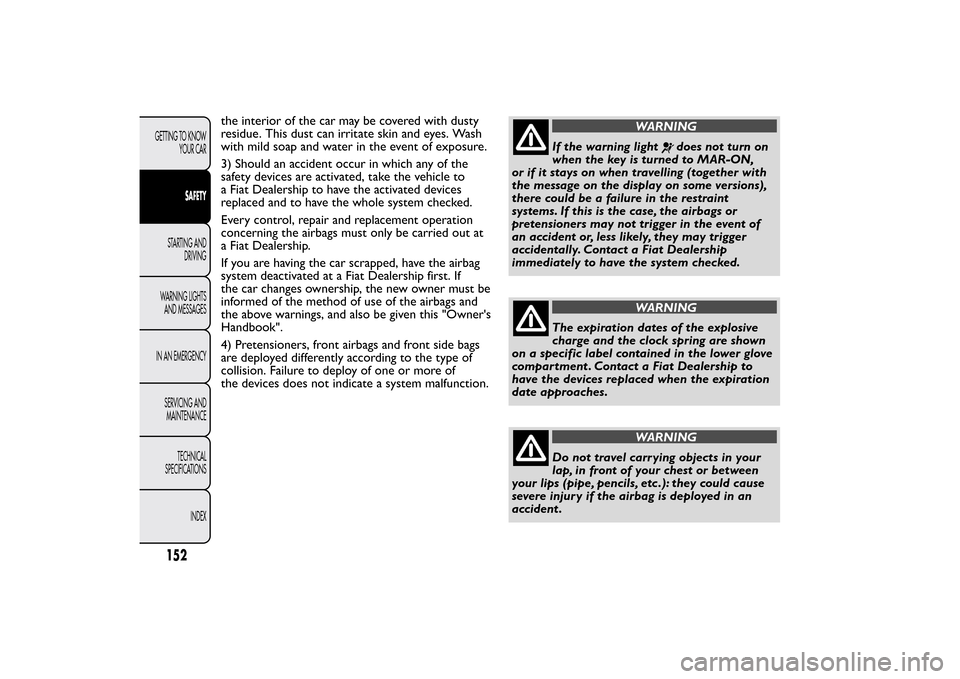
the interior of the car may be covered with dusty
residue. This dust can irritate skin and eyes. Wash
with mild soap and water in the event of exposure.
3) Should an accident occur in which any of the
safety devices are activated, take the vehicle to
a Fiat Dealership to have the activated devices
replaced and to have the whole system checked.
Every control, repair and replacement operation
concerning the airbags must only be carried out at
a Fiat Dealership.
If you are having the car scrapped, have the airbag
system deactivated at a Fiat Dealership first. If
the car changes ownership, the new owner must be
informed of the method of use of the airbags and
the above warnings, and also be given this "Owner's
Handbook".
4) Pretensioners, front airbags and front side bags
are deployed differently according to the type of
collision. Failure to deploy of one or more of
the devices does not indicate a system malfunction.
WARNING
If the warning light
does not turn on
when the key is turned to MAR-ON,
or if it stays on when travelling (together with
the message on the display on some versions),
there could be a failure in the restraint
systems. If this is the case, the airbags or
pretensioners may not trigger in the event of
an accident or, less likely, they may trigger
accidentally. Contact a Fiat Dealership
immediately to have the system checked.
WARNING
The expiration dates of the explosive
charge and the clock spring are shown
on a specific label contained in the lower glove
compar tment . Contact a Fiat Dealership to
have the devices replaced when the expiration
date approaches.
WARNING
Do not travel carrying objects in your
lap, in front of your chest or between
your lips (pipe, pencils, etc .): they could cause
severe injur y if the airbag is deployed in an
accident .
152GETTING TO KNOW
YOUR CAR
SAFETY
STARTING AND
DRIVING
WARNING LIGHTS
AND MESSAGES
IN AN EMERGENCY
SERVICING AND
MAINTENANCE
TECHNICAL
SPECIFICATIONS
INDEX
Page 157 of 299
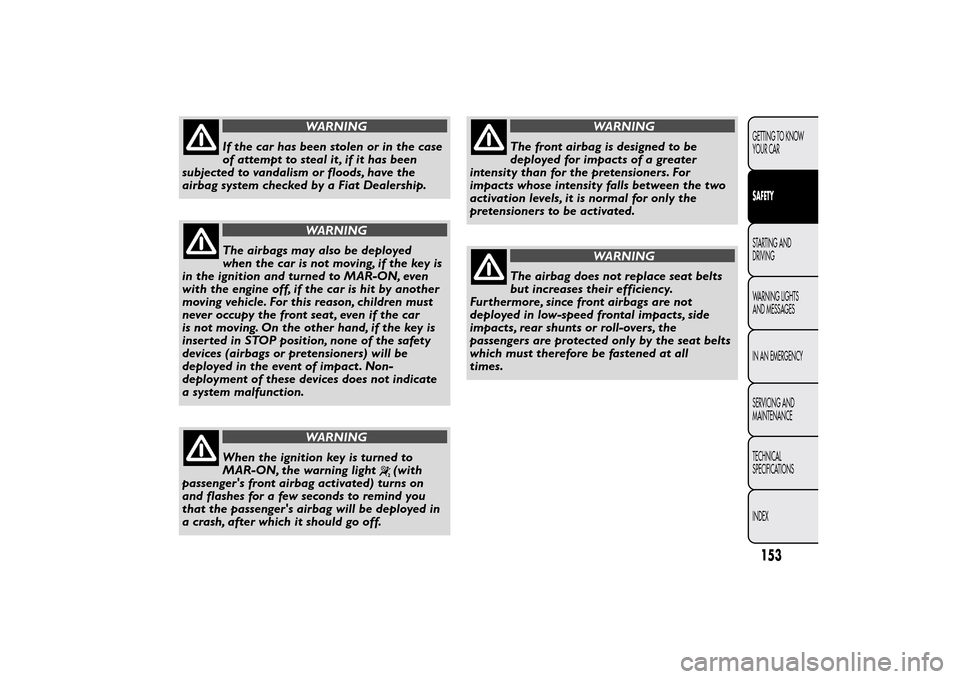
WARNING
If the car has been stolen or in the case
of attempt to steal it , if it has been
subjected to vandalism or floods, have the
airbag system checked by a Fiat Dealership.
WARNING
The airbags may also be deployed
when the car is not moving, if the key is
in the ignition and turned to MAR-ON, even
with the engine off, if the car is hit by another
moving vehicle. For this reason, children must
never occupy the front seat , even if the car
is not moving. On the other hand, if the key is
inserted in STOP position, none of the safety
devices (airbags or pretensioners) will be
deployed in the event of impact . Non-
deployment of these devices does not indicate
a system malfunction.
WARNING
When the ignition key is turned to
MAR-ON, the warning light
(with
passenger's front airbag activated) turns on
and flashes for a few seconds to remind you
that the passenger's airbag will be deployed in
a crash, after which it should go off.
WARNING
The front airbag is designed to be
deployed for impacts of a greater
intensity than for the pretensioners. For
impacts whose intensity falls between the two
activation levels, it is normal for only the
pretensioners to be activated.
WARNING
The airbag does not replace seat belts
but increases their efficiency.
Furthermore, since front airbags are not
deployed in low-speed frontal impacts, side
impacts, rear shunts or roll-overs, the
passengers are protected only by the seat belts
which must therefore be fastened at all
times.
153GETTING TO KNOW
YOUR CARSAFETYSTARTING AND
DRIVING
WARNING LIGHTS
AND MESSAGES
IN AN EMERGENCY
SERVICING AND
MAINTENANCE
TECHNICAL
SPECIFICATIONS
INDEX
Page 158 of 299
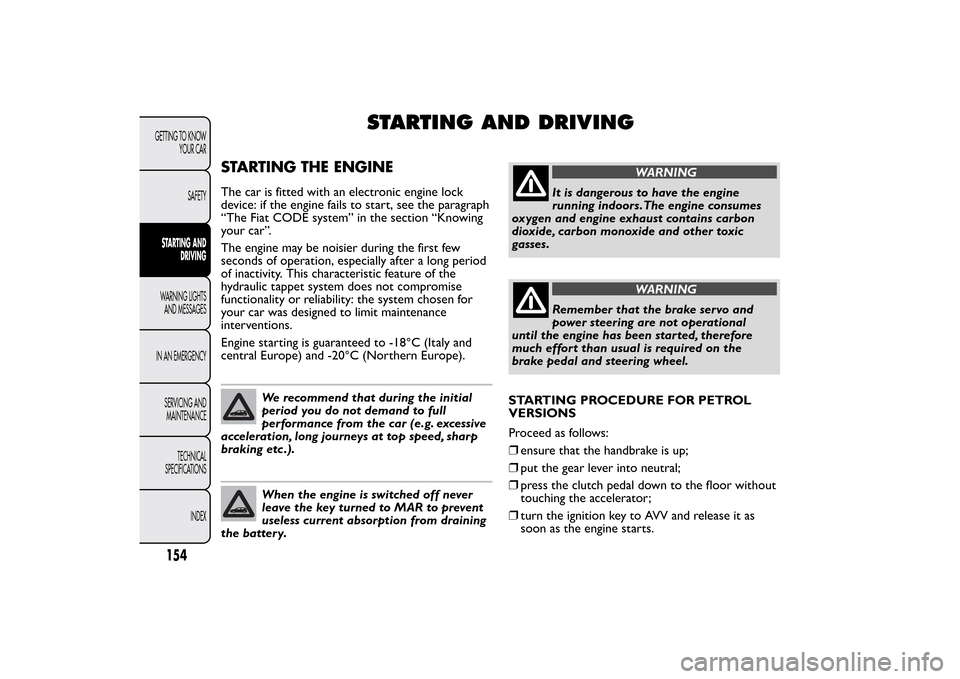
STARTING AND DRIVING
STARTING THE ENGINEThe car is fitted with an electronic engine lock
device: if the engine fails to start, see the paragraph
“The Fiat CODE system” in the section “Knowing
your car”.
The engine may be noisier during the first few
seconds of operation, especially after a long period
of inactivity. This characteristic feature of the
hydraulic tappet system does not compromise
functionality or reliability: the system chosen for
your car was designed to limit maintenance
interventions.
Engine starting is guaranteed to -18°C (Italy and
central Europe) and -20°C (Northern Europe).
We recommend that during the initial
period you do not demand to full
performance from the car (e.g. excessive
acceleration, long journeys at top speed, sharp
braking etc .).When the engine is switched off never
leave the key turned to MAR to prevent
useless current absorption from draining
the battery.
WARNING
It is dangerous to have the engine
running indoors.The engine consumes
oxygen and engine exhaust contains carbon
dioxide, carbon monoxide and other toxic
gasses.
WARNING
Remember that the brake servo and
power steering are not operational
until the engine has been started, therefore
much effort than usual is required on the
brake pedal and steering wheel.
STARTING PROCEDURE FOR PETROL
VERSIONS
Proceed as follows:
❒ensure that the handbrake is up;
❒put the gear lever into neutral;
❒press the clutch pedal down to the floor without
touching the accelerator;
❒turn the ignition key to AVV and release it as
soon as the engine starts.
154GETTING TO KNOW
YOUR CAR
SAFETYSTARTING AND
DRIVINGWARNING LIGHTS
AND MESSAGES
IN AN EMERGENCY
SERVICING AND
MAINTENANCE
TECHNICAL
SPECIFICATIONS
INDEX
Page 159 of 299
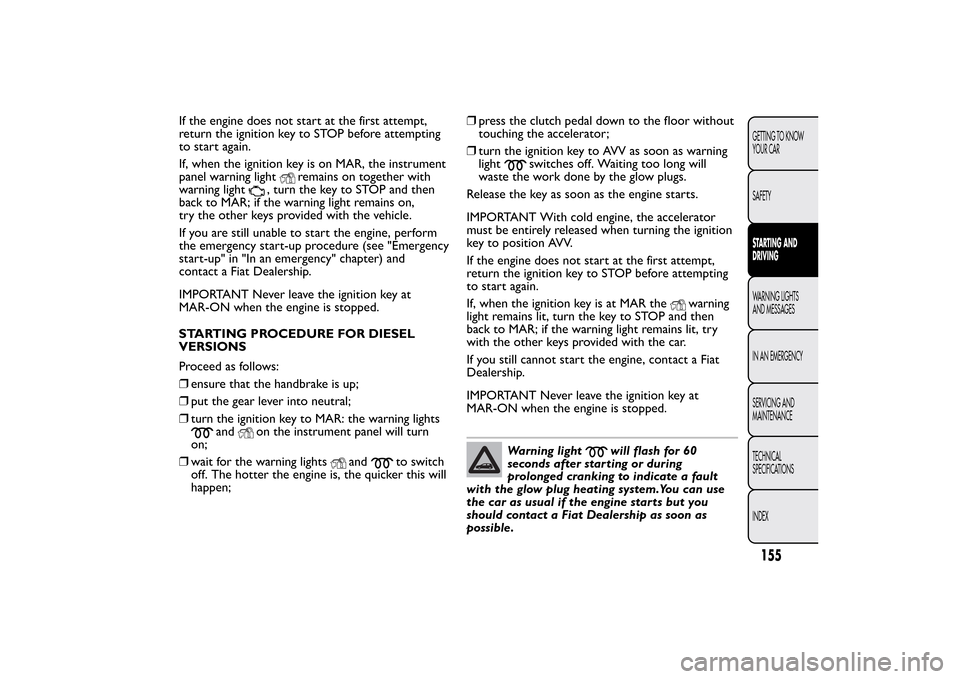
If the engine does not start at the first attempt,
return the ignition key to STOP before attempting
to start again.
If, when the ignition key is on MAR, the instrument
panel warning light
remains on together with
warning light
, turn the key to STOP and then
back to MAR; if the warning light remains on,
try the other keys provided with the vehicle.
If you are still unable to start the engine, perform
the emergency start-up procedure (see "Emergency
start-up" in "In an emergency" chapter) and
contact a Fiat Dealership.
IMPORTANT Never leave the ignition key at
MAR-ON when the engine is stopped.
STARTING PROCEDURE FOR DIESEL
VERSIONS
Proceed as follows:
❒ensure that the handbrake is up;
❒put the gear lever into neutral;
❒turn the ignition key to MAR: the warning lights
and
on the instrument panel will turn
on;
❒wait for the warning lights
and
to switch
off. The hotter the engine is, the quicker this will
happen;❒press the clutch pedal down to the floor without
touching the accelerator;
❒turn the ignition key to AVV as soon as warning
light
switches off. Waiting too long will
waste the work done by the glow plugs.
Release the key as soon as the engine starts.
IMPORTANT With cold engine, the accelerator
must be entirely released when turning the ignition
key to position AVV.
If the engine does not start at the first attempt,
return the ignition key to STOP before attempting
to start again.
If, when the ignition key is at MAR the
warning
light remains lit, turn the key to STOP and then
back to MAR; if the warning light remains lit, try
with the other keys provided with the car.
If you still cannot start the engine, contact a Fiat
Dealership.
IMPORTANT Never leave the ignition key at
MAR-ON when the engine is stopped.
Warning light
will flash for 60
seconds after starting or during
prolonged cranking to indicate a fault
with the glow plug heating system.You can use
the car as usual if the engine starts but you
should contact a Fiat Dealership as soon as
possible.
155GETTING TO KNOW
YOUR CAR
SAFETYSTARTING AND
DRIVINGWARNING LIGHTS
AND MESSAGES
IN AN EMERGENCY
SERVICING AND
MAINTENANCE
TECHNICAL
SPECIFICATIONS
INDEX
Page 160 of 299
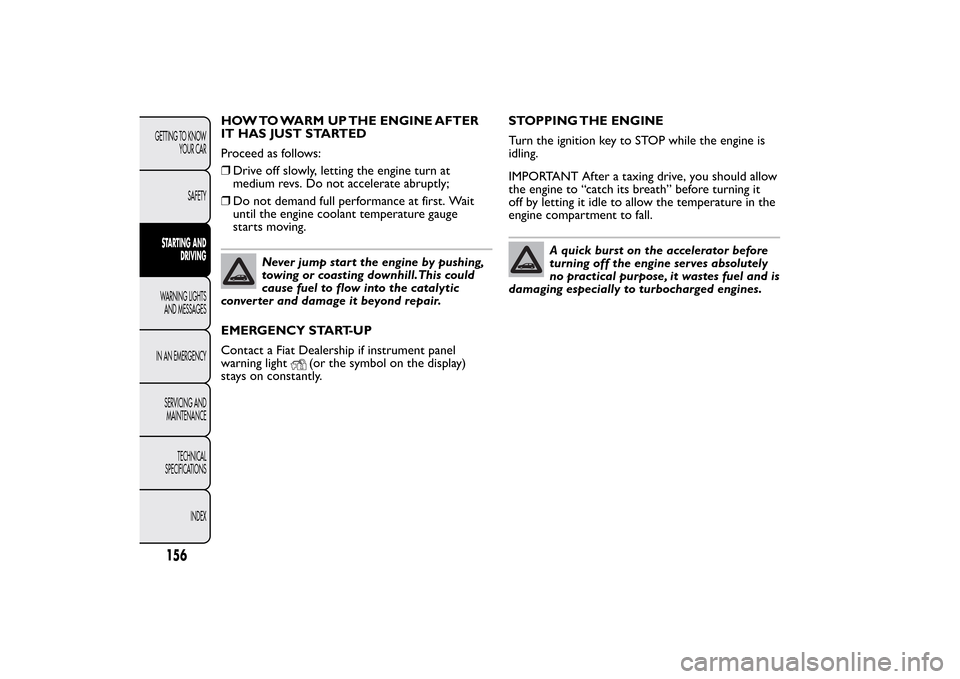
HOW TO WARM UP THE ENGINE AFTER
IT HAS JUST STARTED
Proceed as follows:
❒Drive off slowly, letting the engine turn at
medium revs. Do not accelerate abruptly;
❒Do not demand full performance at first. Wait
until the engine coolant temperature gauge
starts moving.
Never jump start the engine by pushing,
towing or coasting downhill.This could
cause fuel to flow into the catalytic
conver ter and damage it beyond repair.
EMERGENCY START-UP
Contact a Fiat Dealership if instrument panel
warning light
(or the symbol on the display)
stays on constantly.STOPPING THE ENGINE
Turn the ignition key to STOP while the engine is
idling.
IMPORTANT After a taxing drive, you should allow
the engine to “catch its breath” before turning it
off by letting it idle to allow the temperature in the
engine compartment to fall.
A quick burst on the accelerator before
turning off the engine serves absolutely
no practical purpose, it wastes fuel and is
damaging especially to turbocharged engines.
156GETTING TO KNOW
YOUR CAR
SAFETYSTARTING AND
DRIVINGWARNING LIGHTS
AND MESSAGES
IN AN EMERGENCY
SERVICING AND
MAINTENANCE
TECHNICAL
SPECIFICATIONS
INDEX